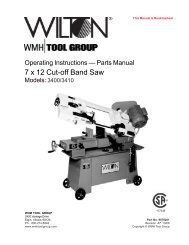This Rigger's Handbook is dedicated to Theodore C - Igor Chudov
This Rigger's Handbook is dedicated to Theodore C - Igor Chudov
This Rigger's Handbook is dedicated to Theodore C - Igor Chudov
Create successful ePaper yourself
Turn your PDF publications into a flip-book with our unique Google optimized e-Paper software.
Load Binders<br />
LOAD BINDER WARNINGS AND APPLICATION INSTRUCTIONS<br />
LOAD BINDER WARNINGS AND<br />
APPLICATION INSTRUCTIONS<br />
• Failure <strong>to</strong> use th<strong>is</strong> load binder properly may result in<br />
serious injury or even death<br />
• Do not operate load binder while standIng on the<br />
load.<br />
• Move handle with caution. It may whip – Keep body<br />
clear.<br />
• Keep yourself out of the path of the moving handle.<br />
• You must be familiar with state and federal<br />
regulations regarding size and number of chain<br />
systems required for securing loads on trucks.<br />
• Always consider the safety of nearby workers as well<br />
as yourself when using load binder.<br />
• While under tension, load binder must not bear<br />
against any object.<br />
• Do not thow these instructions away. Keep them<br />
close at hand and share them with any others who<br />
use th<strong>is</strong> load binder.<br />
RATCHET TYPE<br />
LEVER TYPE<br />
LEVER SNUBBING TYPE LEVER WALKING TYPE<br />
LEVER RELEASING TYPE<br />
WARNING<br />
Mechanical Advantage<br />
Lever Type Binder = 25 : 1<br />
Ratchet Type Binder = 50 : 1<br />
Example: 100 pounds of effort<br />
applied <strong>to</strong> the binder results in<br />
the following force on the binder.<br />
Lever Type:<br />
2500 (100 lbs. x 25) lbs. of force<br />
Ratchet Type:<br />
5000 (100 lbs. x 50) lbs. of force<br />
HEADQUARTERS: 55 James E. Casey Drive • Buffalo, NY 14206 PHONE: 716.826.2636 FAX: 716.826.4412 www.hanessupply.com<br />
50<br />
YOUR SLING AND RIGGING SPECIALIST<br />
INSTRUCTIONS - LEVER TYPE LOAD BINDERS<br />
• Hook load binder <strong>to</strong> chain so you<br />
can operate it while standing on the<br />
ground. Position load binder so its<br />
handle can be pulled downward <strong>to</strong><br />
tighten chain (see pho<strong>to</strong>). Be aware<br />
of ice, snow rain, oil, etc. that can<br />
affect your footing. Make certain<br />
your footing <strong>is</strong> secure.<br />
• The Crosby Group, Inc. specifically<br />
recommends AGAINST the use of a<br />
handle extender (cheater pipe). If sufficient leverage cannot<br />
be obtained using the lever type load binder by itself, a<br />
ratchet type binder should be used.<br />
• If the above recommendation <strong>is</strong> d<strong>is</strong>regarded and a cheater<br />
pipe <strong>is</strong> used, it must closely fit the handle and must slide<br />
down the handle until the handle projections are contacted.<br />
The pipe should be secured <strong>to</strong> the handle, for example, by a<br />
pin, so that the pipe cannot fly off the handle if you lose<br />
control and let go. The increased leverage, by using a<br />
cheater pipe, can cause deformation and failure of the chain<br />
and load binder.<br />
• During and after tightening chain, check load binder handle<br />
position. Be sure it <strong>is</strong> in the locked position and that its<br />
bot<strong>to</strong>m side <strong>to</strong>uches the chain link.<br />
• Chain tension may decrease due <strong>to</strong> load shifting during<br />
transport. To be sure the load binder remains in proper<br />
position: Secure handle <strong>to</strong> chain by wrapping the loose end<br />
of chain around the handle and the tight chain, or tie handle<br />
<strong>to</strong> chain with soft wire.<br />
• When releasing load binder, remember there <strong>is</strong> a great deal<br />
of energy in the stretched chain. <strong>Th<strong>is</strong></strong> will cause the load<br />
binder handle <strong>to</strong> move very quickly with great force when it<br />
<strong>is</strong> unlatched. Move handle with caution. It may whip –<br />
Keep body clear.<br />
• Never use a cheater pipe or handle extender <strong>to</strong> release<br />
handle. Use a steel bar and pry under the handle and stay<br />
out of the path of handle as it moves upward.<br />
• If you release the handle by hand, use an open hand under<br />
the handle and push upward. Do not close your hand<br />
around the handle. Always keep yourself out of the path<br />
of the moving handle.<br />
INSTRUCTIONS - RATCHET LOAD BINDERS<br />
• Position ratchet binder so it can be operated from the ground.<br />
• Make sure your footing <strong>is</strong> secure.<br />
MAINTENANCE OF ALL LOAD BINDERS<br />
• Routinely check load binders for wear, bending, cracks,<br />
nicks, or gouges. If bending or cracks are present – Do<br />
not use load binder.<br />
• Routinely lubricate pivot and swivel points of Lever Binders,<br />
and pawl part and screw threads of Ratchet Binders <strong>to</strong><br />
extend product life and reduce friction wear.
















